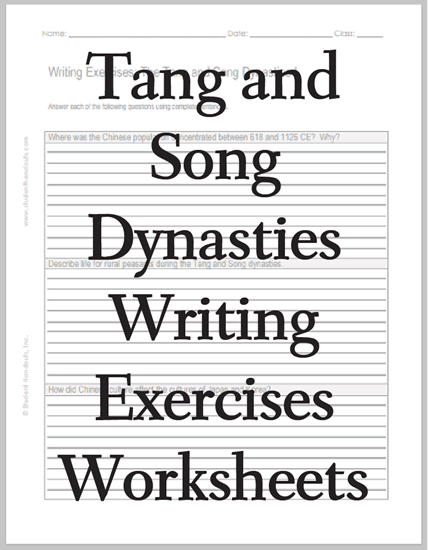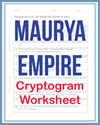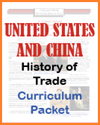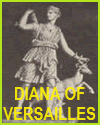| Tang and Song Dynasties Writing Exercises |
|---|
| www.studenthandouts.com ↣ World History ↣ Ancient East Asia ↣ Ancient East Asia Worksheets |
 |  |
|---|
|
Tang and Song Dynasties Writing Exercises Sheet #1: Answer each of the following questions using complete sentences. 1. Where was the Chinese population concentrated between 618 and 1126 C.E.? Why? Between 618 and 1126 C.E., during the Tang and early Song dynasties, China's population was increasingly concentrated in the south, particularly along the Yangtze River. This shift occurred because of fertile farmland, improved rice cultivation, and better irrigation. The region's agricultural productivity supported larger populations, leading to economic growth and the rise of major southern cities like Hangzhou. 2. Describe life for rural peasants during the Tang and Song dynasties. Life for rural peasants during the Tang and Song dynasties was centered on farming, particularly rice cultivation in the south. Most peasants lived in small villages and worked long hours in the fields. While they faced taxes and labor duties, advances in agricultural techniques and tools improved food production. During the Song period, some peasants experienced modest improvements in living conditions and market access. 3. How did Chinese culture affect the cultures of Japan and Korea? Chinese culture significantly influenced Japan and Korea through the spread of Buddhism, Confucianism, writing systems, and government models. Korea adopted Chinese-style bureaucracy and Confucian ideals, while Japan adapted Chinese characters and integrated Buddhism into its native beliefs. Artistic styles, architecture, and legal codes also reflected Chinese influence, though both Japan and Korea developed distinct cultural identities over time. Click here to print. Answers will vary. |
|
Tang and Song Dynasties Writing Exercises Sheet #2: Answer each of the following questions using complete sentences. 1. Why is the Tang dynasty (618-907 C.E.) thought of as a golden age? The Tang dynasty is considered a golden age because it marked a period of political stability, cultural flourishing, and economic prosperity. The empire expanded its territory, reformed the government, and promoted trade along the Silk Road. Literature, art, and technology thrived, with poets like Li Bai and Du Fu emerging. Buddhism also spread widely, influencing Chinese society and architecture. 2. Describe the role of women during the Tang and Song dynasties. During the Tang dynasty, women generally had more social freedom, with some achieving influence in politics, the arts, and religion—most notably Empress Wu Zetian. However, during the Song dynasty, women's status declined due to the rise of Confucian ideals emphasizing male authority and female obedience. Practices like foot-binding began, symbolizing reduced mobility and a more restricted role in society. 3. How was China both isolated from and connected to other regions during the Song dynasty? During the Song dynasty, China was geographically isolated by natural barriers like mountains, deserts, and seas, which limited overland contact. However, it remained well-connected through maritime trade. Chinese merchants and goods reached Southeast Asia, the Indian Ocean, and beyond. Foreign merchants also visited Chinese ports, bringing new ideas, goods, and technologies, making China both a self-sufficient and globally connected civilization. Click here to print. Answers will vary. |
| Ancient East Asia Books and Films | Ancient East Asia Outlines and PowerPoints |
| Ancient East Asia Maps and Pictures | Ancient East Asia Study Games |
| Ancient East Asia Miscellany | Ancient East Asia Worksheets |
| www.studenthandouts.com ↣ World History ↣ Ancient East Asia ↣ Ancient East Asia Worksheets |











